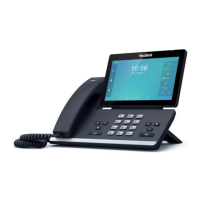Administrator’s Guide for SIP-T5 Series Smart Media Phones
394
presents anonymous.
2) If there is not any Privacy: id header in the INVITE request, the IP phone checks and
presents the caller identification from the P-Preferred-Identity header.
3) If there is not P-Preferred-Identity header in the INVITE request, the IP phone checks and
presents the caller identification from the P-Asserted-Identity header.
Caller ID source = PAI-FROM
1) The IP phone checks Privacy: id header preferentially, if there is a Privacy: id in the INVITE
request, the caller identification information will be hidden and the IP phone touch screen
presents anonymous.
2) If there is not any Privacy: id header in the INVITE request, the IP phone checks and
presents the caller identification from the P-Preferred-Identity header.
3) If there is not P-Preferred-Identity header in the INVITE request, the IP phone checks and
presents the caller identification from the P-Asserted-Identity header.
4) If there is not P-Asserted-Identity header in the INVITE request, the IP phone presents the
caller identification derived from the FROM header.
Caller ID source = RPID-FROM
1) The IP phone checks Privacy: id header preferentially, if there is a Privacy: id in the INVITE
request, the caller identification information will be hidden and the IP phone touch screen
presents anonymous.
2) If there is not any Privacy: id header in the INVITE request, the IP phone checks and
presents the caller identification from the P-Preferred-Identity header.
3) If there is not P-Preferred-Identity header in the INVITE request, the IP phone checks and
presents the caller identification from the Remote-Party-ID header.
4) If there is not Remote-Party-ID header in the INVITE request, the IP phone presents the
caller identification derived from the FROM header.
Caller ID source = PAI-RPID-FROM
1) The IP phone checks Privacy: id header preferentially, if there is a Privacy: id in the INVITE
request, the caller identification information will be hidden and the IP phone touch screen
presents anonymous.
2) If there is not any Privacy: id header in the INVITE request, the IP phone checks and
presents the caller identification from the P-Preferred-Identity header.
3) If there is not P-Preferred-Identity header in the INVITE request, the IP phone checks and
presents the caller identification from the P-Asserted-Identity header.
4) If there is not P-Asserted-Identity header in the INVITE request, the IP phone checks and
presents the caller identification from the Remote-Party-ID header.
5) If there is not Remote-Party-ID header in the INVITE request, the IP phone presents the
caller identification derived from the FROM header.
Caller ID source = RPID-PAI-FROM
1) The IP phone checks Privacy: id header preferentially, if there is a Privacy: id in the INVITE

